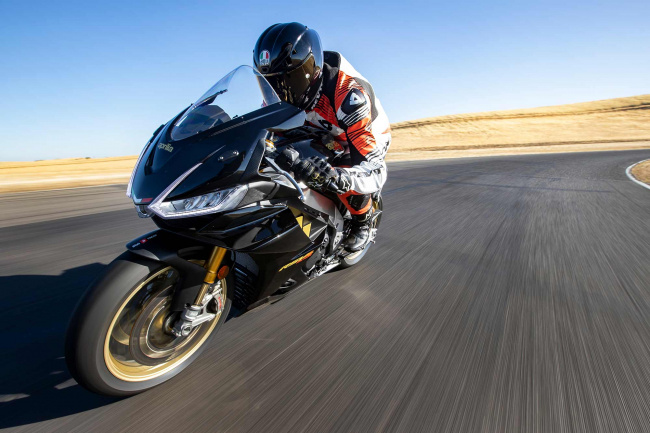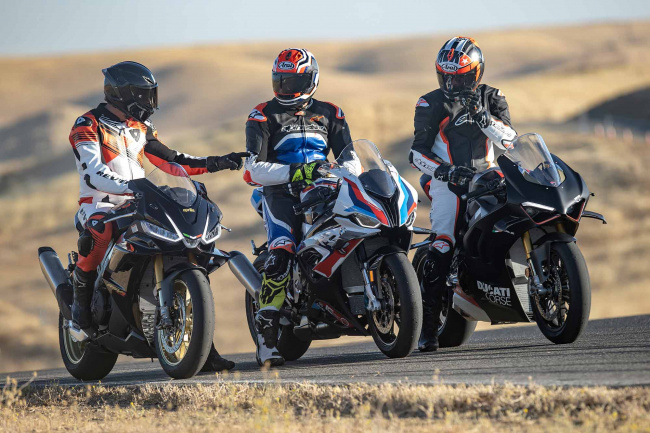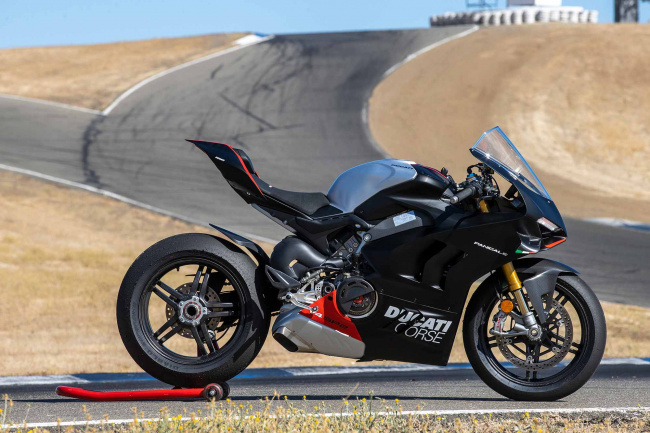A new realm of superbike performance.
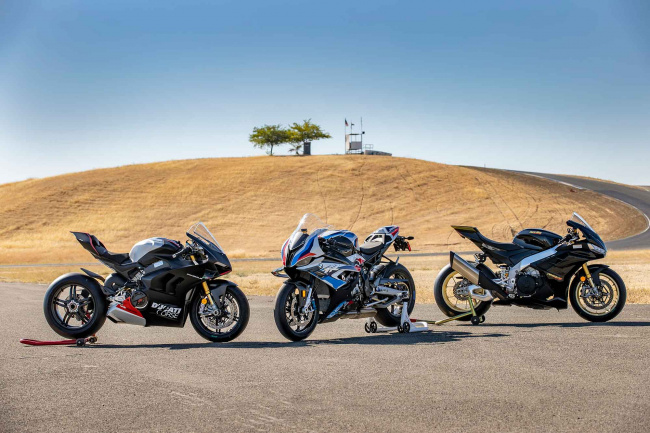
The Superbike Shootout Class of 2022—the reigning champion Aprilia RSV4 Factory, the homologation-special repli-racer BMW M 1000 RR, and the tricked-out Ducati Panigale V4 SP2.
The only things required in the modern-day superbike are the essential go-fast elements of mass horsepower, wicked handling, and a heck of a lot of technology developed at the highest levels of racing. Anything else? Scrap it. Extra interferes with the ultimate goal of the ideal lap time. This is the category that has revolutionized outright road-going motorcycle performance as we know it.
It’s what has made superbikes so super. And every so often, one of these machines comes along and defies the perception of what is possible on two wheels, completely changing our expectations for a high-performance race-bred streetbike. To put things in perspective, a former Cycle World staffer purchased a late-’70s Suzuki GS1000, leaving it in the crate, convinced that performance of such an astonishing level would not be outdone. Boy, was he wrong.
Era-defining motorcycles like the legendary 1986 GSX-R750 followed with its remarkably low weight, high rpm, and unflinching sporting focus for the period. Other milestone machines include the wicked 1998 Yamaha YZF-R1, then the fabled 2005 Suzuki GSX-R1000 otherwise known as the K5, and more recently the technologically sophisticated 2015 Yamaha YZF-R1. Each represents a new realm in conceivable performance relative to its period and was built with the rules of production-based Superbike racing in mind, in order to win on Sunday and sell on Monday. Because if you want a great racebike, you have to start with a great streetbike.
What’s different in this test is that two bikes arrive here flouting any racing rules while one aims to perform within superbike regulations to deliver the best possible racetrack experience. None of these motorcycles are cheap, but considering their relative performance and their high-level industrial art, you could argue there’s a ton of value here. There is nothing better available on two wheels for total sportbike performance—these bikes are it.
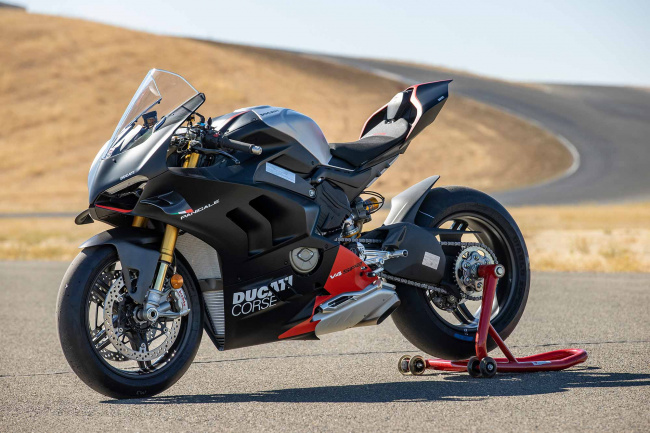
The Ducati Panigale V4 SP2 requires the highest cost of admission—$39,500.
The Ducati Panigale V4 SP2 is the best example of no-holds-barred performance, packed with the oversized 1,103cc Stradale 90-degree V-4 and a whole lot of carbon fiber. Think of it as Ducati building upon the performance of the super-exotic Superleggera V4, Cycle World Ten Best Superbike 2021 champion, and delivering it in a package that’s 60 percent cheaper and more readily available to the customer. It feels as if it was hand built on the workbench alongside Bologna’s World Superbikes.
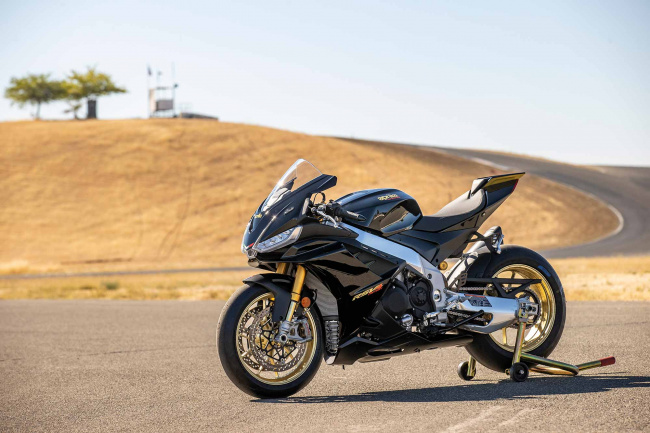
The Aprilia RSV4 Factory returns as our last liter-class shootout’s victor, now with several updates aimed at helping it stay atop the throne.
Aprilia’s RSV4 Factory has a similar story. The winner of Cycle World’s last superbike shootout has a lot on the line. Since that time, Aprilia has bumped displacement of its unrestricted 65-degree V-4 to 1,099cc, fitted top-shelf semi-active Öhlins suspension, and an updated swingarm, among other changes. Aprilia may not be actively competing in superbike racing, but recent MotoGP results are proof of its ongoing expertise.
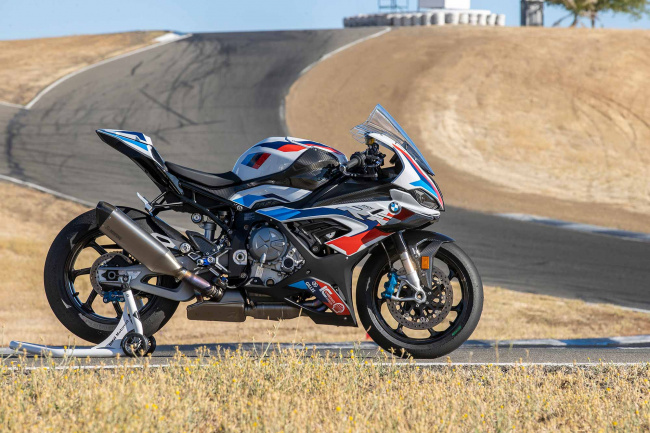
BMW Motorrad does superbike racing in the form of the M 1000 RR. The glistening carbon fiber reminds you of its intent.
In this group, BMW’s M 1000 RR is an outlier by being a homologation-special racing model. It has to be 1,000cc, but it’s the finest, fastest machine Motorrad has to offer. That means it’s the competition-minded descendant of the capable S 1000 RR with every bit of the design focused on finding advantages within the scope of the World Superbike rules package. Yes, there is street-spec equipment, but BMW is just squeaking through DOT and EPA requirements to qualify the M as a for-sale streetbike so it can go racing at one of the highest levels.
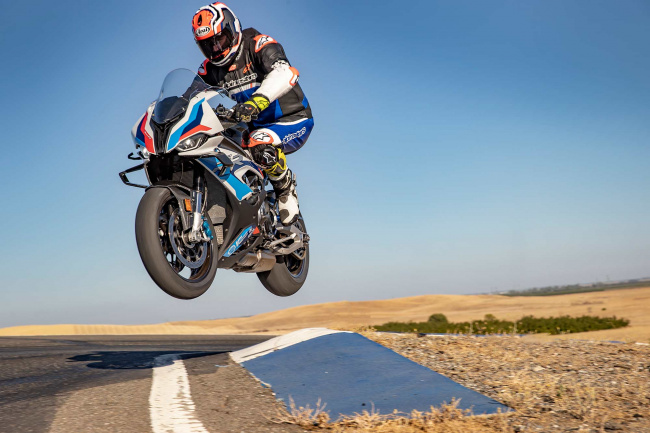
Thunderhill’s dramatic elevation changes and demanding layout left no aspect of performance untested…or fun to be had.
Evaluating the true performance of these open-class machines is a serious task, and for the 2022 Cycle World Superbike Shootout, that meant two full days of highly focused testing on Thunderhill’s 3.0-mile road course. It is a lot of fun and also very intense, particularly with ambient temperatures around 100 degrees. This track is demanding. Packed with dramatic elevation changes, a variety of tight and fast sweeping corners, heavy braking zones, and fifth-gear straightaways, it puts every aspect of these superbikes under the magnifying glass of our handpicked testers. Legendary CW road test editor Don Canet returned to deliver objective evaluations and do the timed hot laps, while in-market editor and experienced professional roadracer Bradley Adams and motorcyclistonline.com senior editor Adam Waheed also handled testing duties.
Prior to on-track testing, we ran every bike on the Cycle World’s in-house Dynojet 250i dynamometer to measure horsepower and torque, then completed objective straight-line performance testing at our private facility. To ensure equal and remarkable grip, we fitted the contenders with the latest Pirelli Diablo Superbike WSBK-spec racing slick (125/70 front and 200/65 rear profiles) and had West Coast Pirelli racing tire distributor CT Racing on-site to lend expertise in keeping the mass power of these superbikes hooked up.
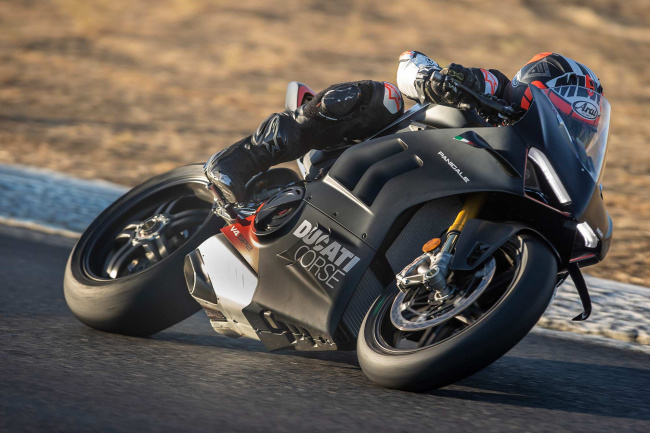
Contrary to the raw physical exertion required on corner entry, the Ducati’s remarkable refinement results in steadfast control and composure at lean.
Raw power and performance is cool and everything, but rideability is always key, and that’s what makes these motorcycles so amazing. It’s not about being the best in a single area, but the most well-rounded in all areas.
How good are these bikes? “I’m truly in awe,” Canet exclaimed while debriefing over the finest local cuisine in Willows, California. “Not only of the performance capabilities of current liter-class sportbikes, but of their approachability—with credit to relentless refinement of electronic rider aids—that’s allowed a much larger rider base to experience the thrill of charging a corner entry, nailing an apex at deep lean, and driving out of an exit with heroic gusto.”
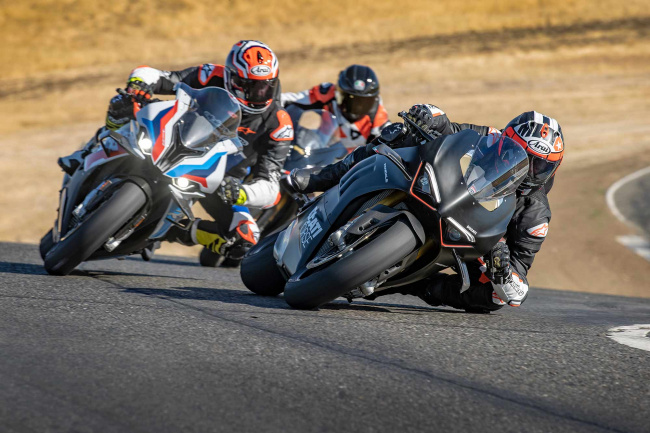
The Ducati Panigale V4 SP2 is all about lean angle all the time.
There’s nothing more heroic than deliberately scraping an elbow on the asphalt for the first time at 60 years old, as Canet did in the sweeping Turn 2 while aboard the $39,500 Ducati Panigale V4 SP2. Among many amazing qualities of the Ducati, none is greater than its superb chassis. Phenomenal balance and composure lend themselves to maximum rider confidence at ridiculous lean angles, and the bike doesn’t budge in any circumstance. At 415 pounds with an empty fuel tank, the Ducati isn’t the lightest in the test, but it is the most nimble through side-to-side transitions and has impressive midcorner steering. It has a laserlike focus on apexes, compared to the lightness and precision of an inline-four middleweight by testers, thanks to its carbon fiber wheels. Smash apexes quickly and move on.

This STM-EVO dry clutch adds to the Panigale’s ruthless personality. The clatter steals the show in the paddock.
The Ducati has ripping horsepower and a whole lot of charisma built into its mighty V-4 engine. The 1,103cc Stradale’s 182 hp and 79 lb.-ft. of torque is smack in the middle of the Aprilia and BMW, but it feels and sounds as if it produces the most of everything. The clatter of the STM-EVO dry clutch is a nod to Bologna’s racing roots. As Waheed put it, “Carl Fogarty could have only dreamt of the borderline psychotic acceleration that this bike offers. Yet true to its roots it has the soul of Ducati’s previous V-twins. It’s truly remarkable.”
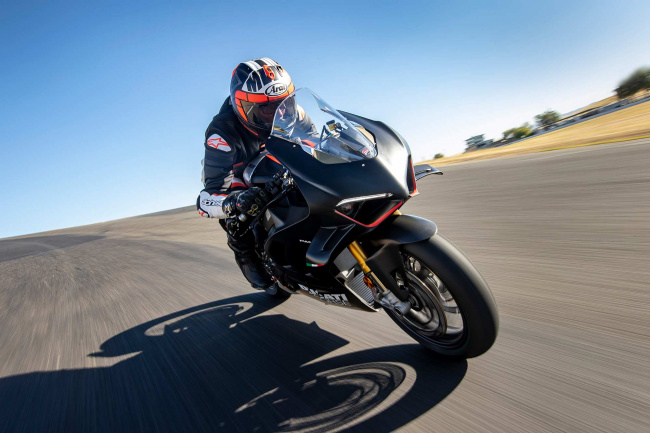
The Ducati sounds the most spectacular of all three bikes, off and on the throttle.
The Ducati’s beauty is a balance of thrill and tractable delivery. Immediate throttle response promotes a strong connection between man and machine, the most of any bike in the test, without feeling overly aggressive or abrupt. It’s a controlled use of power with a lot of credit due to the superb electronic rider aid interventions. Ducati’s ultraprecise traction, slide, and wheelie control systems are simply unmatched, allowing optimal flat-track-like wheelspin for relentless corner exits and elegant low-trajectory wheelies under extreme acceleration. The advantage is recognizable via quickest split times in hard-acceleration sectors four and five and outright quickest lap time. At wide-open throttle, a hard hit in the midrange makes it feel the fastest despite trap speeds overshadowed by the BMW.
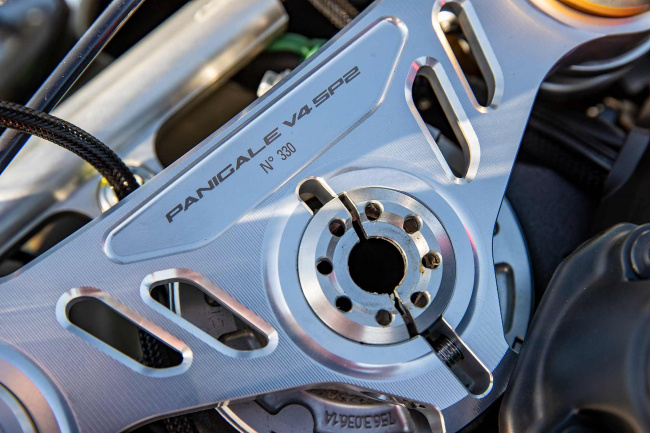
Ducati is in the details.
Taking advantage of the Ducati’s sheer acceleration is one thing, but slowing it down is another. It’s easy to make friends with the SP2′s top-spec Brembo Stylema R caliper’s (plus an OE-fitted remote adjuster on the left handlebar!) outstanding power and lever feel paired with rock-solid chassis composure for mind-warping corner entry speeds in total confidence. But that takes energy. A lot of it. Ducati claims to have revised the smooth curvature of the fuel tank shape to better utilize lower body strength for support, but testers noted that hard deceleration induces tiring pressure on your arms and wrists. Add that to the higher speed and extra Gs that the Ducati’s steadfast control is capable of, and the SP2 is demanding through pure force. Get in shape! Your Ducati deserves it…
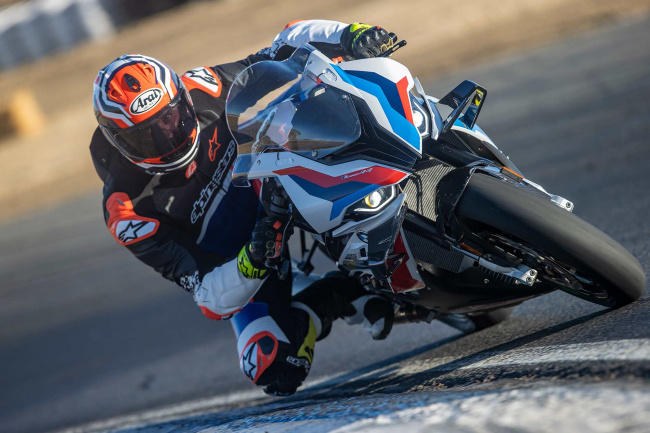
The M 1000 RR is the lightest bike of this year’s test at 403 pounds without fuel, which is best demonstrated by its precise steering and nimbleness on track.
Opposite to the Ducati in terms of physical exertion, at least at corner entry, is the BMW M 1000 RR. The M RR is the lightest of the test at 403 pounds empty of fuel—that’s 10 pounds under the Ducati and 32 pounds less than the Aprilia—and its extremely nimble chassis is proof. Our muscles thank you, Motorrad! Snapping through side-to-side transitions and hunting apexes requires little more than a thought of when and where you want to go. It’s the most precise steering motorcycle in the test. The BMW is capable of a solid chassis balance and composure, but required ongoing damping and ride height adjustments to find the sweet spot. Once dialed in, there’s no arguing its corner carving prowess.
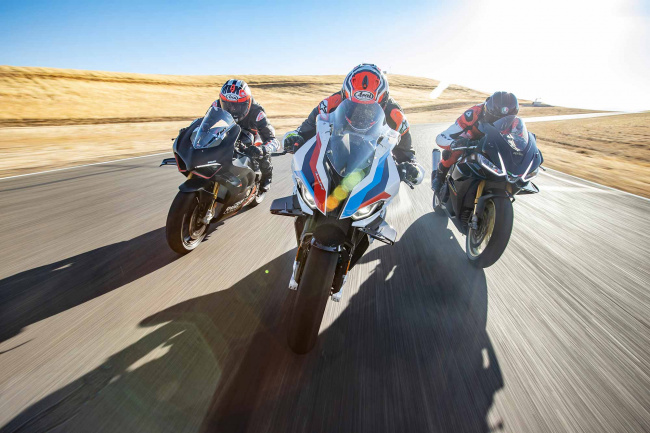
There’s no shortage of power in this year’s shootout. The combined total of all three bikes is 550 ripping horsepower!
There’s something to be said for the ergonomic fit of the M RR in relation to its handling. A comfortable riding position for testers of all shapes and sizes (trick, OE-fitted billet adjustable rearsets help with the positioning) with enough leverage helps to muscle the motorcycle through demanding sections of track. The end result is a motorcycle that requires less physical exertion throughout the course of a trackday. That means more laps in anger.
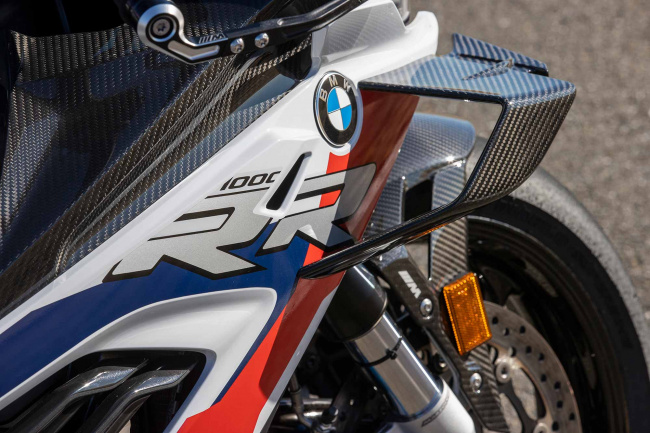
Subjectively, the BMW M 1000 RR’s wings are the most eye-catching of the bunch, providing critical downforce under hard acceleration.
Good thing, because where the chassis reduces physical effort, keeping the BMW’s 999cc inline-four powerplant spinning will require brain power. The 179 hp and 76 lb.-ft. of torque peak performance is no joke, albeit the least of the trio and less than the previous S 1000 RR we had on our dyno. Midrange power delivery is electronically reduced to make the bike meet US sound regulations, as clearly shown on the dyno chart. Power delivery off idle is strong, then suddenly drops between 6,000 and 8,000 rpm to quiet the bike before regaining oomph as it rips toward its 15,100 rpm redline. It’s a bipolar personality and frustrating when you’re trying to nail a fast lap. And there’s a relentless engine vibration at every rpm. Maintaining midcorner speed means attacking corners like an inline-four middleweight and hustling lots of precise shifts—even utilizing first gear in the tight Turn 11. Get it right, and be rewarded with quick and consistent times. But keeping the revs up induces physical and mental fatigue, even throughout a single lap.
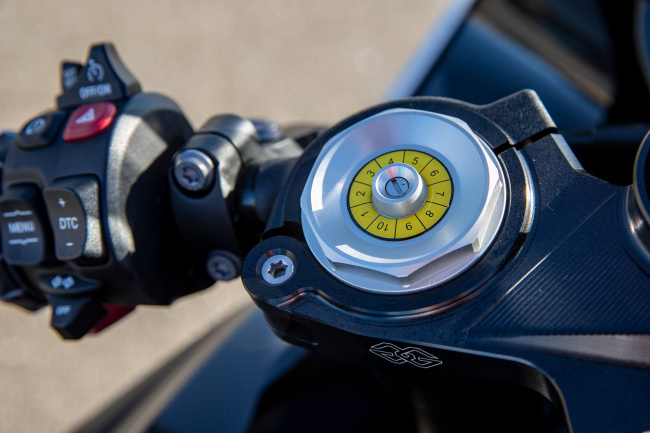
As the only motorcycle in the test without semi-active suspension, the BMW M 1000 RR required more setup time. Still, smooth action and overall composure were phenomenal.
The BMW’s engineering reminds you that it’s built for racers looking to extract every ounce of performance. The $37,490 sticker price is the result of a whole lot of exotic material, CNC-machined components, a titanium Akrapovič exhaust, and the countless hours and extensive cost of engine development, including titanium con-rods and other trick internal pieces. Perfect your riding technique, dial in the chassis setup just right, and Motorrad is destined to fight for victory.
Cycle World scales.” src=”https://cdn.topcarnews.info/wp-content/uploads/2023/01/28025614/image-superbike-shootout-aprilia-rsv4-factory-vs-bmw-m-1000-rr-vs-ducati-panigale-v4-sp2-406b3154538ebcb69f734dea714b760c.jpg”>
Despite being stopped by a pair of Brembo Stylema calipers, the Aprilia RSV4 Factory stops in a longer distance than the others, likely due to being the heaviest at 435 pounds empty of fuel on the Cycle World scales.
Class-leading engine performance and relentless power delivery is most of what keeps the RSV4 Factory in the fight. Its measured peak 189 hp and 85 lb.-ft. of torque is ridiculous considering it’s a completely stock road-legal motorcycle, but its user-friendliness and overall flexibility are the most appealing traits. An aggressive throttle connection combined with immediate torque allows it to jump off a corner while the ripping mid-to-top-end power seemingly never stops. Despite gearing being noticeably taller than that of its competitors, gear selection is less crucial for a quick lap time—there is just so much power available everywhere in the rpm range.
